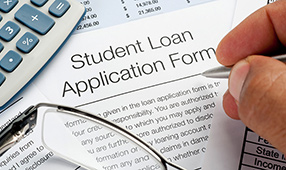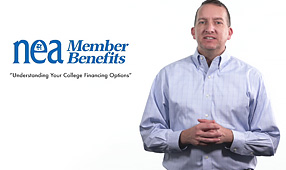The beauty of student loans is that they help you achieve your goal of becoming a teacher by financing your own education. However, these loans can get pretty burdensome, if you don’t make smart choices when taking them out and repaying them.
Deciding how to pay for college takes some research and planning. Here are 5 expert tips to borrow and repay your student loans at the lowest possible cost to you.
1. Get the best student loans for your circumstances.
Start with the Free Application for Federal Student Aid (FAFSA). After you complete the paperwork and it is accepted and assessed, you’ll know if you’re eligible for federal loans and if the amount is enough or you’ll need to explore private student loans.
Be aware that private loans have higher interest rates and different repayment terms than their federal counterparts. “Only consider them after exhausting every other option,” says Jacqueline Moreno, Chief Service Officer for the Illinois Student Assistance Commission.
You may be entitled to scholarships, grants, internships and employer tuition remission. That’s free money that can help reduce the amount you need to borrow. Contact your university for more information on such programs.
Find out more about the distinctions between federal and private loans as well as key questions to ask yourself about your college loan needs to help you make an informed decision.
2. Borrow the correct amount.
Just because you’re awarded a large loan doesn’t mean you should accept the full amount. “The biggest mistake students make when planning for college and deciding how much to borrow is ignoring the return on investment,” Moreno says.
Understand what you can expect to earn and compare it to the cost of earning that degree or credential. Visit salary.com to see how much you may make, or check nea.org for the latest data about educator salaries by state, level of education and more, then weigh it against what you may have to pay. Assess your needs carefully, then borrow accordingly.
Already on the job but your salary is insufficient to cover typical payments? Look into loan forgiveness programs, which can eliminate a portion of your debt.
Another option for NEA members is to use the NEA Student Debt Navigator. The tool analyzes your loan information and displays available repayment and forgiveness options side-by-side. This service is offered at no cost through the first year through our Members Insurance Trust program.
3. Get on the correct repayment schedule.
Most borrowers immediately start the standard 10-year repayment plan, but this is by no means the only option. Depending on your financial circumstances, you may want to explore the alternatives:
- Accelerated repayment. Want to pay your loans early? You can, and with no prepayment penalties. This plan is right if you have no other loans with a higher rate of interest and can afford the higher payments.
- Graduated repayment. With this plan, payments start out low (though never below the interest amount) and increase every few years. Payments can stretch up to 30 years. This option can be attractive if you don’t earn much now but expect that you will in the future.
- Extended repayment. If you need fixed monthly payments for up to 30 years, the extended plan may be right for you. Keep in mind, though, that you’ll pay more in interest with this plan than other types of repayment plans.
- Income driven repayment. This plan looks at your income, family size and loan amount when determining your monthly payment. Each year your financial circumstances are reassessed, which will cause your payments to rise and fall depending on your current earnings.
4. Consider consolidating your student loans.
You can lower your monthly payments by combining several loans into one packaged loan and extending the repayment period. Consolidation can be a good option if the bulk of your loans are federal (private loans are generally not combined with federal loans), and if the new interest rate is better than what you are currently receiving. The fixed rate for a consolidation loan is calculated by the weighted average of the loans being consolidated, and rounded up to the nearest one-eighth of 1 percent.
However, there are some drawbacks to consolidation, such as paying more in interest or losing the option for loan cancellation, so evaluate your own circumstances carefully before choosing this option. You can check the NEA Student Debt Navigator first to explore any forgiveness options that may be available to you before you lock yourself into a refinanced private loan that will negate your future forgiveness eligibility.
Do you have high interest private loans? If you’ve been paying them on time for a few years and your credit is good, request a rate reduction. Or shop around for a single loan with better terms to cover the entire amount.
5. Don’t let your loan go into default.
It is extremely important to keep your loans in good standing because the consequences of default are severe. These include:
- Aggressive debt collection tactics
- Interception of tax refund money you’re owed
- Lawsuits
- Nonjudicial wage garnishment
- Ineligibility for deferments, flexible repayment options, grants and new student loans
- Collection fees
- A default notation on your credit report (which remains until the loan is cleared)
Pay attention to all mail from your loan holder, and request that communication come to you in email for an electronic record. If at any point you can’t make your payments, you may apply for a deferment (suspension of payments and interest) or a forbearance (suspension of payment only).
Ultimately, student loans can be an inexpensive way to pay for your schooling. Borrow prudently, get on the most appropriate repayment schedule for your needs, and never—ever—let them go into default. By following these guidelines, you’ll save yourself a huge amount of time and money.
Take control of your student loans and start saving today!
Whether you're looking for ways to reduce your monthly payments, explore forgiveness options or find the right refinance solution, NEA Member Benefits is here to help. Our NEA Student Debt Navigator can guide you through available forgiveness programs, while our NEA Student Loan Refinance Program offers competitive rates to help you manage or reduce your loan burden.
Visit the link below to find the best solutions tailored to your needs as an educator and take the first step toward financial freedom.









